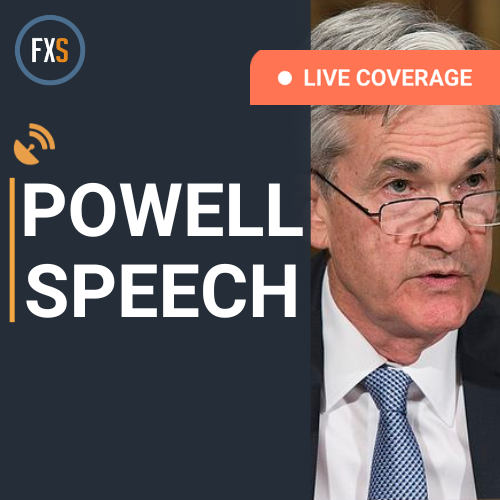- Jerome Powell’s testimony in the US Congress will be a top-tier market-moving event this week.
- New clues on the Federal Reserve interest rate path are awaited.
- US Dollar, stock markets, and other asset classes could see big swings with the Fed Chair’s words.
Jerome Powell, Chairman of the US Federal Reserve (Fed), will deliver the Semi-Annual Monetary Policy Report and testify before the Senate Banking Committee on Tuesday. The hearing, entitled “The Semi-Annual Monetary Policy Report to the Congress,” will start at 14:00 GMT, and it will have the full attention of all financial market players.
Jerome Powell is expected to address the main takeaways of the Fed’s Semi-Annual Federal Reserve Monetary Policy Report, published last Friday. In that report, the Fed noted that they have seen modest further progress on inflation this year but added that they still need greater confidence before moving to rate cuts. “Labor supply and demand resembles period right before the pandemic, when the labor market was relatively tight but not overheated,” the publication read.
US representatives are expected to ask Powell about the interest rate path, inflation developments, and the economic growth outlook in a long Q&A session. However, they could focus on politics because of the upcoming November Presidential election, making it difficult for Powell to respond to questions.
The CME Group FedWatch Tool shows that markets price in only 25% probability that the Fed will leave the policy rate unchanged in September. The latest jobs report showed that US Nonfarm Payrolls (NFP) rose 206,000 in June. This reading came in above the market expectation of 190,000, but the US Bureau of Labor Statistics (BLS) announced that May’s NFP increase was revised down to 218,000 from 272,000. Additionally, the Unemployment Rate edged higher to 4.1% from 4%, while the annual wage inflation, as measured by the change in the Average Hourly Earnings, declined to 3.9% on a yearly basis from 4.1%.
In case Powell adopts an optimistic tone about the inflation outlook and acknowledges loosening conditions in the labor market, investors could remain optimistic about a September rate cut. The market positioning suggests that there is some room for further US Dollar (USD) weakness in this scenario. On the other hand, market participants could reassess the probability of a rate reduction in September and help the USD hold its ground if Powell downplays the gloomy labor market figures and remains cautious about the continuation of disinflation.
Economic Indicator
Fed’s Chair Powell testifies
Federal Reserve Chair Jerome Powell testifies before Congress, providing a broad overview of the economy and monetary policy. Powell’s prepared remarks are published ahead of the appearance on Capitol Hill.
Next release: Tue Jul 09, 2024 14:00
Frequency: Irregular
Consensus: –
Previous: –
Source: Federal Reserve
About Jerome Powell (via Federalreserve.gov)
“Jerome H. Powell first took office as Chair of the Board of Governors of the Federal Reserve System on February 5, 2018, for a four-year term. He was reappointed to the office and sworn in for a second four-year term on May 23, 2022. Mr. Powell also serves as Chairman of the Federal Open Market Committee, the System’s principal monetary policymaking body. Mr. Powell has served as a member of the Board of Governors since taking office on May 25, 2012, to fill an unexpired term. He was reappointed to the Board and sworn in on June 16, 2014, for a term ending January 31, 2028.”
Fed FAQs
Monetary policy in the US is shaped by the Federal Reserve (Fed). The Fed has two mandates: to achieve price stability and foster full employment. Its primary tool to achieve these goals is by adjusting interest rates. When prices are rising too quickly and inflation is above the Fed’s 2% target, it raises interest rates, increasing borrowing costs throughout the economy. This results in a stronger US Dollar (USD) as it makes the US a more attractive place for international investors to park their money. When inflation falls below 2% or the Unemployment Rate is too high, the Fed may lower interest rates to encourage borrowing, which weighs on the Greenback.
The Federal Reserve (Fed) holds eight policy meetings a year, where the Federal Open Market Committee (FOMC) assesses economic conditions and makes monetary policy decisions. The FOMC is attended by twelve Fed officials – the seven members of the Board of Governors, the president of the Federal Reserve Bank of New York, and four of the remaining eleven regional Reserve Bank presidents, who serve one-year terms on a rotating basis.
In extreme situations, the Federal Reserve may resort to a policy named Quantitative Easing (QE). QE is the process by which the Fed substantially increases the flow of credit in a stuck financial system. It is a non-standard policy measure used during crises or when inflation is extremely low. It was the Fed’s weapon of choice during the Great Financial Crisis in 2008. It involves the Fed printing more Dollars and using them to buy high grade bonds from financial institutions. QE usually weakens the US Dollar.
Quantitative tightening (QT) is the reverse process of QE, whereby the Federal Reserve stops buying bonds from financial institutions and does not reinvest the principal from the bonds it holds maturing, to purchase new bonds. It is usually positive for the value of the US Dollar.

